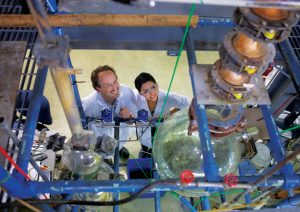Teaching Discovery Through Smart Experimentation
 John Crocker studies “squishy stuff.” A researcher at the nexus of soft-matter physics and cell biology, Crocker employs various methods to develop new materials, to determine how soft (or squishy) a material is, and in the case of living cells, to learn how they determine the squishiness of their own surroundings. As an associate professor in the Department of Chemical and Biomolecular Engineering (CBE), Crocker spends each fall semester guiding Penn Engineering’s CBE seniors through that “rite of passage” currently known as CBE 410: Chemical Engineering Laboratory.
John Crocker studies “squishy stuff.” A researcher at the nexus of soft-matter physics and cell biology, Crocker employs various methods to develop new materials, to determine how soft (or squishy) a material is, and in the case of living cells, to learn how they determine the squishiness of their own surroundings. As an associate professor in the Department of Chemical and Biomolecular Engineering (CBE), Crocker spends each fall semester guiding Penn Engineering’s CBE seniors through that “rite of passage” currently known as CBE 410: Chemical Engineering Laboratory.
A required course of CBE undergraduates, CBE 410 is an all-laboratory course focused on the application of concepts learned throughout the curriculum, such as heat and mass transfer, thermodynamics, fluid mechanics, and separation processes. Students find themselves in the same space where decades of alumni have taken the course: Room 116 Towne Building. It is a space that exudes chemical engineering in its arrangement of glassware, tubes and wires, the hissing of steam from the two-story-high distillation column and an industrial-grade catwalk made of welded steel.
With very little instruction, students spend two weeks per laboratory station to determine how to use, manipulate and reconfigure the equipment to achieve success in each process. At the beginning of the semester, students are understandably apprehensive, knowing they not only need to remember and apply years of theory, but also figure out how the equipment they are using even works. “As an educator,” states Katherine J. Stebe, Richer and Elizabeth Goodwin Professor and Chair of CBE, “John emphasizes independence of thought, the thrill of discovery, smart experimentation, strong analysis and clear communication on the part of students. He gets them to take initiative to perform each lab unit as a project, which is particularly important as students prepare to launch into professional careers or into post-graduate programs.”
Crocker’s own research extracts mechanical measurements and builds new nanoscale materials, and his findings inform the research of biologists and engineers searching for novel therapies and devices. It is learning how cells gauge their surroundings that has Crocker intrigued. While understanding how a cell reacts to a chemical is not difficult, discovering how a cell senses mechanical forces or the mechanical properties of its surrounding tissue is far more challenging. “Until we can explain these determinations, there is a void in the cognizance of diseases like cancer, where cells are mutated and fail to determine that the mutation has occurred or that they have metastasized to a distant organ,” reasons Crocker.
Crocker’s ongoing research also includes the use of DNA as an adhesive to cause microscopic particles to spontaneously assemble themselves into new unique materials. This is achieved via the use of the DNA double-helix’s predictable pairings of adenine with thymine and guanine with cytosine. Once a string of these pairs is designed, the double-helix is “unzipped” and each half is attached to one of the two particle types that the Crocker lab is planning to combine. When mixed in solution, the halves find one another and “zip” together, forming a new particle alloy. According to Crocker, “we won’t be constructing buildings out of these materials anytime soon,” but several scientists at Penn and other institutions are testing the usefulness of these new materials and their potential future applications in optics and electronics.
Crocker marvels at the history of the School and his role in the future of CBE education and research. Poised at a new frontier of cell biology science and excited to cultivate the next generation of chemical and biomolecular engineers, Crocker represents much more than the two words “squishy stuff” imply. He is part of the vibrant tapestry of learning, teaching, innovation and discovery that is unique to Penn Engineering.
